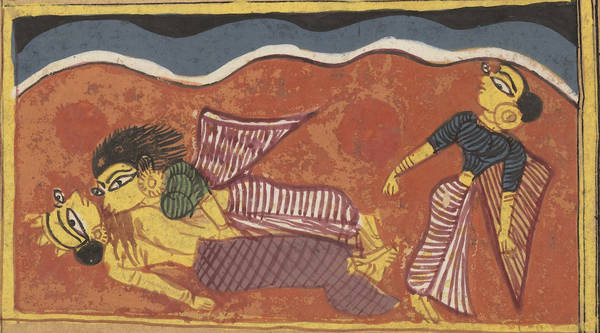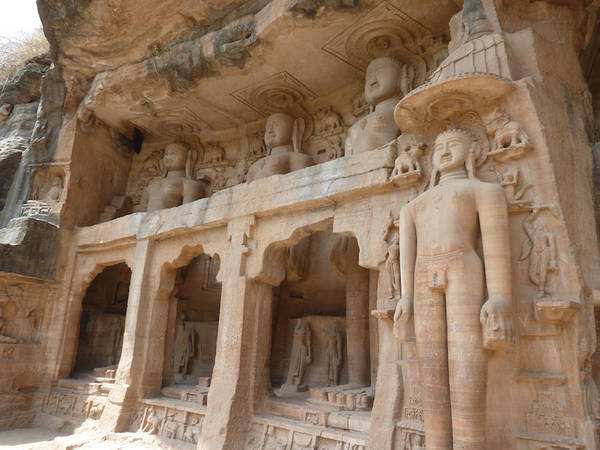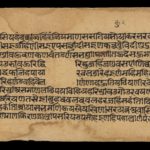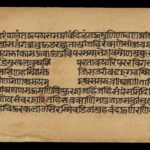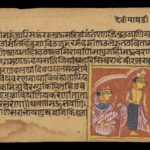Article: Story of Yaśodhara
The Story of Yaśodhara is one of the most important Jain tales and has been passed down through the centuries in all the languages Jains have used. It is a good representative of religious teaching in narrative form – dharma-kathā. Its importance comes from the fact that it shows very clearly the working of karma and rebirth and refers to key concepts in these notions, such as violence – hiṃsā – both factual and intentional, and desire or greediness. Ultimately, all the protagonists will become pious Jains and will be emancipated.
In addition, the tale is interesting from a wider religious angle because it shows the rivalry between Jainism and Hinduism – or, more precisely, Śaivism – and their ways of worship. Another striking point is how frequently animals appear in the story -– as potential sacrificial victims or as possible forms of rebirths.
The story is eventful, colourful and sad or even gloomy in places. Human feelings and reactions are finely depicted through the various episodes, happy or unhappy, that make up life. All the ingredients for a vivid story are found in the tale of Yaśodhara. The tale has also inspired rich visuals, found in several illustrated manuscripts, all created in Digambara circles (Doshi 1985, Garg 1991).
The version composed by the Digambara poet Raidhū in the 15th century is one of the highlights of JAINpedia. Copies of the Jasahara-cariu, as it is known, are rare even in India so the manuscript held in the Wellcome Trust in London is a precious example, especially as this version of the story is not yet published. Even though it is not a complete manuscript and little is known about it, the Wellcome Jasahara-cariu showcases some fine paintings. Like other versions of the tale of Yaśodhara, the Jasahara-cariu is a major source of Digambara illustrated manuscripts.
The story
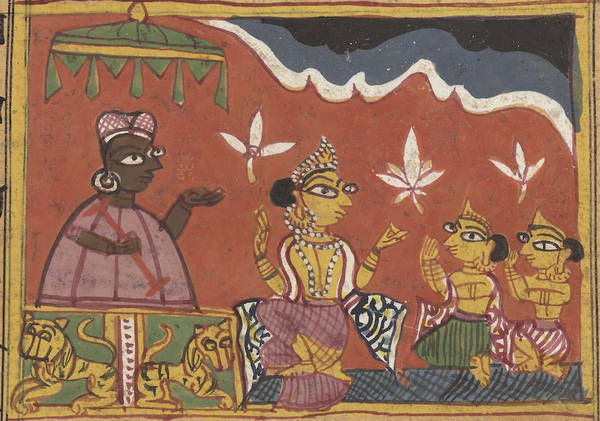
Bhairavānanda commands the king
Image by Wellcome Trust Library © Wellcome Library, London
King Māridatta of Rājapura learns that a Śaiva ascetic called Bhairavānanda has reached his city. Bhairavānanda possesses superhuman powers so the king invites him to the palace and asks whether he could develop such powers.
The ascetic says he could, provided the king makes sacrifices to the goddess Caṇḍamārī, with offerings of a male and female of every living species.
The king assembles such pairs. However, when Bhairavānanda is about to start the ritual, he notices there is no human pair ready for sacrifice. The king dispatches his men to bring him a man and a woman.
Two Jain novices brought for sacrifice
It so happens that the king’s men come across a pair of young Jain ascetics, a boy named Abhayaruci and his twin sister, Abhayamati. They have come into the neighbourhood of Rājapura with a group of Jain monks led by Sudatta.
The men take the young ascetics to the temple of Caṇḍamārī to be sacrificed.
King Māridatta is intrigued by the noble behaviour of the two young ascetics and urges the boy to tell their story. He finally agrees to do so, telling all the episodes of their earlier lives up to the present one. Abhayaruci says that they are rebirths of King Yaśodhara and his mother Candramati.
In most versions of the tale, Abhayaruci narrates his previous births in the first person.
Tale of Yaśodhara begins
In Ujjayinī, the former king was Yaśogha or Yaśorha. He and his queen, Candramati, had a son named Yaśodhara. He becomes king after his father decides to renounce worldly life and become a monk. The young king’s favourite queen is Amṛtamati.
Yaśodhara discovers his betrayal
Amṛtamati falls in love with a hunch-backed elephant-keeper whose melodious singing has captured her heart. One night she leaves her bed to join her paramour, but the king follows her. He discovers the couple but does not reveal himself. Yaśodhara hears his wife tell her lover that she will pray to the goddess for her husband to die.
Yaśodhara is extremely disturbed but does not say anything. After that he cannot take any satisfaction in the pleasures of royal life.
Sacrificing a flour cockerel
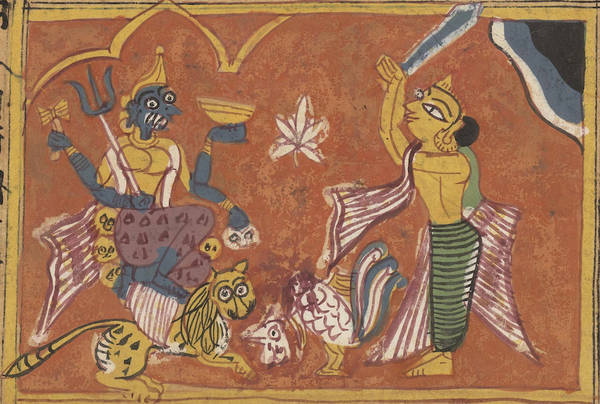
Yaśodhara performs the sacrifice
Image by Wellcome Trust Library © Wellcome Library, London
Yaśodhara goes to his mother Candramatī for help, saying that he wants to die because of a bad dream. He is about to commit suicide in front of her.
Candramatī promises to help by sacrificing a cockerel to the goddess Caṇḍamārī. Yaśodhara refuses this idea because he does not want to commit any violence.
Then his mother proposes making the sacrifice with a cockerel made of flour instead of a living bird. Yaśodhara accepts this suggestion.
They have a very lifelike cockerel made out of flour. Then they both go to the temple and perform the sacrifice.
Yaśodhara and Candramati die
Yaśodhara is still full of disgust at his wife’s betrayal. He decides to give the kingdom to his son Yaśomati and renounce worldly life.
His wife Amṛtamati puts on a show of great sadness. She pretends that she will accompany her husband in entering religious life.
Queen Amṛtamati invites Yaśodhara and Candramati to a final feast, where she serves them poisoned food. Candramati dies instantly.
While Yaśodhara lies on the ground in agony, Amṛtamati throws herself on him, weeping as if overcome with grief, and kills him.
Unaware of how they have died, Yaśomati performs funeral rites for his father and grandmother and becomes the king.
Parallel rebirths
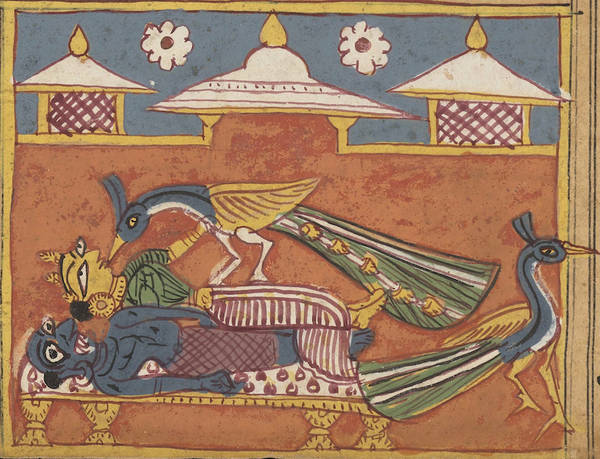
Peacock attacks Amṛtamati
Image by Wellcome Trust Library © Wellcome Library, London
Sacrificing a flour animal is a sin because, even though it is not a living being, the worshippers treat it as one and thus they commit a kind of mental violence.
As a result of their shared sin, the souls of both Yaśodhara and Candramati endure several rebirths. To a large extent, these rebirths run in parallel and their past link continues over their new lives. In several cases, they also come across King Yaśomati, their son and grandson respectively, although they cannot identify each other.
|
Yaśodhara |
Candramati |
|---|---|
|
Reborn as a peacock |
Reborn as a dog in Yaśomati’s palace |
|
Reborn as a snake |
Reborn as a mongoose or porcupine |
|
Reborn as a fish |
Reborn as a crocodile |
|
Reborn as a goat’s son |
Reborn as a wild goat |
|
Reborn as a goat’s kid |
Reborn as a goat |
|
Reborn as a buffalo |
|
|
Reborn as a cockerel |
Reborn as a hen |
|
Reborn as Prince Abhayaruci |
Reborn as Princess Abhayamati |
Conversion of King Yaśomati
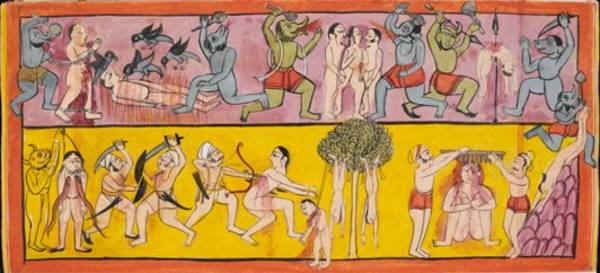
Tortures in the hells
Image by British Library © CC0 1.0 (Creative Commons Public Domain)
One day King Yaśomati goes on a hunting expedition and on the way he passes a Jain monk named Sudatta. The king returns later without any game and again meets the Jain monk. Yaśomati concludes that the monk is a bad omen and sets his dogs to attack him. But the dogs stand still with their heads bent. The angry king then wants to kill the monk with his sword, but is stopped by a merchant devotee.
Yaśomati learns that Sudatta was a former king who has renounced the world to atone for the sin of punishing an innocent person. King Yaśomati is impressed and so ashamed of his behaviour that he wants to kill himself.
The mendicant guesses his thoughts and stops him.
Yaśomati then asks Sudatta where his father, mother and grandmother are.
The monk answers: “Your father, Yaśodhara, and your grandmother, Candramati, have been reborn as your children, Abhayaruci and Abhayamati. Your mother, Amṛtamati, has been reborn in the fifth hell, as a punishment for her vicious behaviour.”
King Yaśomati renounces the householder life and becomes a monk.
Abhayaruci and Abhayamati recall their earlier lives when they hear the monk’s words and faint. When they regain consciousness, they too want to become mendicants. But as they are very young Sudatta advises them to become junior mendicants – kṣullakas.
King Māridatta converts to Jainism
When Abhayaruci the young monk finishes his story, King Māridatta realises that he had been about to commit violence by the sacrifice he wanted to offer. The Śaiva ascetic Bhairavānanda has a similar reaction.
Both men give up their former styles of worship and decide to offer non-violence towards living beings. They take the vows of the Jain mendicant and become disciples of the monk Sudatta.
Numerous versions
The story of Yaśodhara has been extremely popular for centuries among members of both major Jain sects and is found either as an independent tale or in collections of Jain stories.
It would be irrelevant and almost impossible to give an exhaustive list of all versions. The scholar Hiralal Jain listed 30 versions in 1972 and added: “I do not feel confident that my list is exhaustive”.
The table gives a representative selection of versions.
|
Author |
Title |
Language |
Date |
Scholarly reference |
|
|---|---|---|---|---|---|
|
Samarāiccakahā |
Māhārāṣṭrī Jain Prakrit |
eighth century |
|
||
|
Hariṣeṇa |
Bṛhatkathākośa |
931 CE |
Hardy 1990 |
||
|
Somadeva |
Yaśastilaka-campū |
Digambara |
Sanskrit |
959 CE |
Handiqui 1968 |
|
Jasahara-cariu |
Digambara |
972 CE |
Jain 1972 |
||
|
Vādirāja |
Yaśodhara-carita |
|
Sanskrit |
second half of the tenth century |
|
|
Janna |
Yaśodhara-carite |
Digambara |
Kannada |
1209 CE |
Sharma 1994 |
|
Māṇikyadeva-sūri |
Yaśodhara-carita |
Sanskrit |
unknown |
|
|
|
Sakalakīrti |
Yaśodhara-carita |
Digambara |
Sanskrit |
15th century |
Bhaskar 1988 |
|
Raidhū |
Jasahara-cariu |
Digambara |
Apabhraṃśa |
15th century |
|
|
unknown |
Yaśodhara-kāvya |
Tamil |
unknown |
Chakravarti 1974: 84–90 |
|
|
Lakṣmīdās |
Yaśodhara-carita |
Digambara |
1724 CE |
|
Wellcome Trust manuscript
On JAINpedia, the story of Yaśodhara is represented by the Wellcome Trust manuscript Beta 1471, which has been fully digitised. It contains the version of the story by the poet Raidhū, called Jasahara-cariu. A Digambara Jain of the 15th century, when large parts of the subcontinent were under the Mughals, he mainly lived in Gwalior – in present-day Madhya Pradesh – in the reigns of the Tomara kings, Ḍūṃgarasiṃha and his son Kīrtisiṃha.
Raidhū is known to have supervised about 1500 carvings of Jain idols on the outer walls of the Gwalior fort. Raidhū was closely connected with the Jain authorities and prominent personalities. One of these was Hemarāja, whose name appears in the colophons at the end of each section of his poem on Yaśodhara. He was Raidhū’s childhood friend and a prominent Jain devotee who gained the title of sanghapati – ‘leader of the community’. A member of the Agrawal caste, he was one of Raidhū’s protectors.
Raidhū wrote numerous narrative and didactic poems, mainly in Apabhraṃśa, a late form of Prakrit used extensively by Jain Digambara authors from the ninth century onwards. At the time Raidhū wrote, India was under Islamic control, yet the languages used were forms of the modern languages of northern India such as Old Hindi, Old Rajasthani or Old Gujarati. But Apabhraṃśa was still a literary language favoured by poets and scholars.
Jasahara-cariu
Raidhū’s version of Yaśodhara’s story is known by the title Jasahara-cariu, which means ‘the story of Yaśodhara’ in Apabhraṃśa. It has the subtitle of ‘having the characteristic of compassion’ – daya-lakkhaṇa. This underlines the main teaching of the story, which is a manifesto against violence of all types and a defence of non-violence.
The text is divided into four sections called sandhi and covers all the episodes described above.
|
Section |
Narrative |
|---|---|
|
section 1 |
|
|
section 2 |
|
|
section 3 |
|
|
section 4 |
|
Coming after so many authors who reworked the story of Yaśodhara, it is to be expected that Raidhū is indebted to his predecessors. The one to whom he owes the most is the tenth-century writer Puṣpadanta, who also composed in Apabhraṃśa.
The text of the Jasahara-cariu has not yet been published, but its contents have been analysed by the Indian scholar Rāja Rām Jain. He is a specialist in Raidhū, editing and translating several of his works and devoting an extensive study in Hindi to Raidhū’s writings (Jain 1974: 348–361; 608–611).
Few manuscripts of this work seem to be known. Jain could use only two for his 1974 publication – one from Jaipur and another one owned by the Ailak Pannalal Digambar Jain Sarasvati Bhavan in Beawar, Rajasthan. The latter was completed in Ahmedabad in 1712 CE. Both manuscripts are illustrated and represent different pictorial traditions. The Jaipur manuscript has 63 pictures, and the Beawar one 70. Some were used by Doshi (1985) and Garg (1991) but none has been analysed and described thoroughly.
Under these circumstances, the Wellcome Trust manuscript is a rarity – indeed, it is unique outside India. It is all the more regrettable then that it is not complete, in that:
- folio 6 is missing
- the available portion ends with folio 41 so that only the first parallel rebirth of Yaśodhara and Candramati as, respectively, a peacock and dog, is covered.
The manuscript has 34 illustrated pages whereas its complete form is likely to have had roughly double that number. The Beawar manuscript has a total of 70 and the black and white reproductions in Jain (1974) show that its style is very close to that of the Wellcome Trust manuscript.
Artistic tradition

Yasodhara and Amṛtamati in love
Image by Wellcome Trust Library © Wellcome Library, London
The Story of Yaśodhara is one of the most important sources for Jain illustrated manuscripts created by Digambaras. However, the style of art depends on the region and on the time the paintings were completed.
There is no date for the incomplete Wellcome Trust manuscript, but it is likely that it goes back to the 18th century, like the Beawar manuscript which is so close in style. Both have colourful and lively scenes, where the figures are proportional and realistic.
See Doshi 1985, Garg 1991 and Jain (1974: 601ff.) for more details.
Reading
- Yaśodharacaritam
Sakalakīrti - edited by Bhagacandra Jain Bhaskar
Sanmati Risarca Insṭīṭyuṭa āpha Inḍolājī (Sanmati Research Institute of Indology); Nagpur, Maharashtra, India; 1988
- Jaina Literature in Tamil
A. Chakravarti - Jñānapīṭha Mūrtidevī Granthamālā: English series
Bhāratīya Jñānapītha Publication; Delhi, India; 1974
- Yaśodharacarita sacitra pāṇḍulipiyāṃ
Kamalā Garga - Bhāratīya Jñānapīṭha; New Delhi, India; 1991
- Yaśastilaka and Indian Culture
K. K. Handiqui - Jīvarāja Jaina Granthamālā series; volume 2
Jaina Samskriti Samraskshaka Sangha; Sholapur, Maharashtra, India; 1968
- ‘Karmic Retribution: The Story of Yaśodhara from the Bṛhatkathākośa’
Freidhelm Hardy - The Clever Adulteress and Other Stories: A Treasury of Jain Literature
edited by Phyllis Granoff
Mosaic Press; Oakville, Ontario, Canada; New York, USA; London, UK; 1990
- Raidhū sāhitya kā ālocanātmak-pariśīlan
Raja Ram Jain - Jaina Shastra aur Ahimsa Research Institute; Vaishali, Bihar, India; 1974
- Tale of the Glory-Bearer: The Episode of Candaśāsana
Janna - translated and edited by T. R. S. Sharma
Penguin Classics series
Penguin Books India; New Delhi, India; 1994
Links
- Sudatta and Yaśomati
-
A zoomable manuscript painting in the Los Angeles County Museum of Art shows the Jain monk Sudatta receiving King Yaśomati. This 17th-century folio from a manuscript of the popular Jain tale Story of Yaśodhara has a picture of a royal procession on the verso side.
- +
- aAbhavya
- aAbhinandana
- aAbhiṣeka
- aĀcāra
- aĀcārāṅga-sūtra
- aĀcārya
- aAchalbhrata
- aAḍhāī-dvīpa
- aAdharma
- aAdho-loka
- aAdhyayana
- aAdvaita Vedānta
- aĀgama
- aAghātīya
- aAghātīya-karman
- aAgnibhuti
- aAgra
- aĀhāra
- aAhiṃsā
- aAhimsa Day
- aAjita
- aAjīva
- aAkampit
- aĀkāśa
- aAkbar the Great
- aAkṣaya-tṛtīyā
- aAlauddin Khalji
- aAlbert Einstein
- aAllah
- aAlms
- aĀlocanā
- aAloka-ākāśa
- aAmāri
- aAmbikā or Kūṣmāṇḍinī
- aAnagāra
- aAnanta
- aAnarthadaṇḍa
- aAnaśana
- aAnekānta-vāda
- aAṅga
- aAniconism
- aAnojjā
- aAntarāla
- aAntarāya-karma
- aAṇu
- aAṇu-vrata
- aAnukampā
- aAnuprekṣā
- aAnusvāra
- aApabhraṃśa
- aAparigraha
- aAra
- aĀrambha
- aĀrambhaja
- aĀratī
- aArdhamāgadhī Prākrit
- aArhaṃ
- aArhat
- aArśana-āvaraṇīya-karma
- aĀrta-dhyāna
- aĀryikā
- aĀryikā Jñānamati
- aĀśātanā
- aĀścarya
- aAscetic
- aAsceticism
- aAshram
- aAspiration
- aĀsrava
- aAṣṭa-maṅgala
- aAṣṭāpada
- aAstikāya
- aAstrolabe
- aAsura
- aAtheism
- aAticāra
- aAtiśayakṣetra
- aAtithisaṃvibhāgavrata
- aĀtma-vāda
- aĀtman
- aAuṃ
- aAurangzeb
- aAuspicious
- aAusterity
- aAvadhāna
- aAvadhi-jñāna
- aĀvaraṇī-yakarman
- aAvasarpiṇī
- aAvatāra
- aAvidyā
- aAxiom
- aĀyāga-paṭa
- aĀyambil
- aĀyu-karma
- aĀyurveda
- bBabur
- bBāhubali
- bBaladeva
- bBālāvabodha
- bBandha
- bBasadi
- bBazaar
- bBhadrankarvijay
- bBhagavant
- bBhaktāmara-stotra
- bBhakti
- bBhale
- bBharata
- bBhāṣā
- bBhāṣya
- bBhaṭṭāraka
- bBhāva
- bBhāva-pūjā
- bBhāvanā
- bBhavana-vāsin
- bBhavya
- bBhavyatva
- bBhaya
- bBhoga-bhūmi
- bBhogopabhoga
- bBodhi
- bBollywood
- bBrahmā
- bBrahma-deva
- bBrahmacārī
- bBrāhmaṇa
- bBraj Bhāṣā
- bBright fortnight
- bBritish Raj
- bBuddha
- bBuddhi-sagar
- bBuddhism
- bBuddhist
- cCaitya
- cCaityavāsin
- cCakravartin
- cCakreśvarī
- cCāmara
- cCandanā
- cCandragupta
- cCandraprabha
- cCanon
- cCāritra
- cCāritramohanīya-karman
- cCarũrī
- cCaste
- cCaturvidha-saṅgha
- cCaturviṃśati-stava
- cCāturyāma
- cCE
- cCelibacy
- cCha
- cChadmastha
- cChastity
- cCheda-sūtra
- cChristian
- cChristianity
- cClergy
- cCloning
- cColophon
- cCommentary
- cConch
- cConfession
- cCongregation
- cConsecration
- cCosmology
- cCremation
- cCrore
- cCult
- cCūrṇi
- dDādā-guru
- dDalit
- dDāna
- dDaṇḍa
- dDark fortnight
- dDarśana
- dDarśanamohanī-yakarman
- dDaśa-lakṣaṇa-parvan
- dDeity
- dDelhi Sultanate
- dDerāsar
- dDeśāvakāśika-vrata
- dDetachment
- dDevanāgarī
- dDevānandā
- dDevarddhi-gani
- dDevotee
- dDhamal
- dDhanuṣ
- dDhāra
- dDharma
- dDharma-dhyāna
- dDharma-sāgara
- dDharmastikaya
- dDhātakīkhaṇḍa
- dDholak
- dDhyāna
- dDiaspora
- dDig-vrata
- dDigambara
- dDīkṣā
- dDisciple
- dDīvālī
- dDivya-dhvani
- dDNA
- dDoctrine
- dDogma
- dDonor
- dDoṣa
- dDravya
- dDravya-pūjā
- dDrone
- dDuṣamā
- dDuṣamā-duṣamā
- dDuṣamā-suṣamā
- dDveṣa
- dDvīpa
- eEast India Company
- eEightfold Path
- eEkānta-vāda
- eEkendriya
- eElder
- eElders
- eEschatology
- eEtc up to
- fFarmān
- fFast
- fFatehpur Sikri
- fFestival
- fFestschrift
- fFiruz Shah
- fFly-Whisks
- fFolio
- fFour Noble Truths
- gGaccha
- gGaṇa
- gGaṇadhara
- gGanadharavada
- gGaṇeśa
- gGaṇin
- gGarba
- gGarbha
- gGarbha-gṛha
- gGaruḍa
- gGati
- gGene
- gGenomics
- gGhātī-yakarman
- gGhātīya
- gGhaznavid
- gGhiyasuddin Tughlaq
- gGhurid
- gGloss
- gGotra-karma
- gGujarāt
- gGujarati
- gGuṇa
- gGuṇa-sthāna
- gGuṇa-vrata
- gGupti
- gGuru
- gGuruṇī
- hHagiography
- hHajj
- hHaṃsa
- hHaribhadra
- hHariṇaigameṣin
- hHasta
- hHeresy
- hHiṃsā
- hHindi
- hHindu
- hHinduism
- hHīravijaya
- hHoroscope
- hHrīṃ
- hHumayun
- hHymn
- iIconoclasm
- iIconography
- iIdol
- iIndian Independence
- iIndology
- iIndra
- iIndrabhūti Gautama
- iIndriya
- iInitiation
- iIntercession
- iInvocation
- iIQ
- iIslam
- iIslamicate
- iIṣṭadevatā
- iĪśvara
- jJagat
- jJahangir
- jJain
- jJaina Devanāgarī
- jJaina Śaurasenī
- jJaina-dharma
- jJainaśāsana
- jJainness
- jJaisalmer
- jJamāli
- jJambū-dvīpa
- jJames Burgess
- jJanma
- jJanma-kalyāṇa
- jJarā
- jJāti
- jJina
- jJina-āgama
- jJina-bhavana
- jJina-bimba
- jJina-mātā
- jJinacandra-sūri
- jJinadatta
- jJinaprabha
- jJīva
- jJñāna
- jJñāna-āvaraṇīya-karma
- jJñāna-āvarṇiya
- jJñānsundar
- jJyotiṣka
- kKāla
- kKālakācārya-kathā
- kKālidāsa
- kKalpa-sūtra
- kKalpa-vṛkṣa
- kKalyāṇaka
- kKalyanvijay
- kKamaṇḍalu
- kKamaṭha
- kKarma
- kKarma-bhūmi
- kKarma-grantha
- kKarma-prakṛti
- kKarma-vāda
- kKarmon
- kKarnataka
- kKaṣāya
- kKathā
- kKāvya
- kKāya
- kKāyotsarga
- kKeśa-loca
- kKetu
- kKevala-jñāna
- kKevalin
- kKhalji
- kKharatara-gaccha
- kKnowledge
- kKriyā
- kKriyā-vāda
- kKṛṣṇa
- kKṣamā-śramaṇa
- kKṣapakaśreṇi
- kKṣatriya
- kKṣullaka
- kKulakara
- kKundakunda
- kKunthu
- lLabdhi
- lLaity
- lLakh
- lLāñchana
- lLands of Action
- lLaukāntika
- lLavaṇa-samudra
- lLeśyā
- lLiṅga
- lLinguistics
- lLoka
- lLoka-ākāśa
- lLoka-puruṣa
- lLoka-vāda
- lLotus
- lLotus lake
- mMadhya-loka
- mMahā-videha
- mMahā-vrata
- mMahābhārata
- mMahāmastakābhiṣeka
- mMāhārāṣṭra
- mMāhārāṣṭrī Prākrit
- mMahattarā Yākinī
- mMahāvīr Jayantī
- mMahāvīra
- mMakāra
- mMakkhali Gośāla
- mMalli
- mMāna-stambha
- mManaḥ-paryāya-jñāna
- mMaṇḍala
- mMaṇḍapa
- mMandit
- mMaṅgala
- mMantra
- mMantras
- mManuṣya-loka
- mMarāṭhī
- mMārgaṇā
- mMartyr
- mMarudevī
- mMaṭha
- mMati-jñāna
- mMauryaputra
- mMecca
- mMendicant lineage
- mMetarya
- mMiracle
- mMithyādṛṣṭi
- mMohandas Gandhi
- mMohanīya-karma
- mMokṣa
- mMonastic order
- mMonasticism
- mMonk
- mMonotheism
- mMosque
- mMount Meru
- mMount Sammeta
- mMṛgāvatī
- mMughal
- mMuhammad
- mMuhammad bin Tughlaq
- mMuhpattī
- mMūla-sūtra
- mMūlaguṇa
- mMumbaī
- mMuni
- mMunisuvrata
- mMurad Bakhsh
- mMūrti-pūjaka
- mMuslim
- mMysticism
- nNābhi
- nNāga-kal
- nNāgapurīya Tapā-gaccha
- nNāgarī
- nNāma-karma
- nNamaskāra-mantra
- nNami
- nNandīśvara-dvīpa
- nNandivardhana
- nNandyāvarta
- nNāraka
- nNāraki
- nNasalisation
- nNātha
- nNavrātrī
- nNaya-vāda
- nNemi
- nNidāna
- nniggaṃthāṇa vā 2
- nniggaṃtho vā 2
- nNigoda
- nNihnava
- nNikṣepa
- nNirgrantha
- nNirjarā
- nNirvāṇa
- nNiryukti
- nNiṣidhi
- nNitya
- nNiyati
- nNo-kaṣāya
- nNudity
- nNun
- oOcean of milk
- oOmniscience
- oOrdination
- ppa°
- pPadmaprabha
- pPadmāsana
- pPadmāvatī
- pPādukā
- pPalanquin
- pPalette
- pPañca-muṣṭi
- pPāṇḍava
- pPaṇḍit
- pPandit Dalsukh D. Malvania
- pPandit Sukhlalji
- pPāṇipātra
- pPāpa
- pParamātman
- pParameṣṭhin
- pPāraṇā
- pParigraha
- pPariṇāma
- pParīṣaha
- pParokṣa
- pPārśva
- pPārśvanātha
- pParyāya
- pParyuṣaṇ
- pPaṭa
- pPatan
- pPātra
- pPenance
- pPersian
- pPhala
- pPhilology
- pPicchikā
- pPilgrimage
- pPīr
- pPolymath
- pPoṣadha
- pPossession
- pPothī
- pPrabhas
- pPradakṣiṇā
- pPradeśa
- pPrākāra
- pPrakīrṇaka-sūtra
- pPrākrit
- pPramāda
- pPramukhā
- pPrati-vāsudeva
- pPratikramaṇa
- pPratimā
- pPratiṣṭhā
- pPratyākhyāna
- pPratyakṣa
- pPravacana
- pPrāyaścitta
- pPrayer
- pPre-modern
- pPreach
- pPredestination
- pProtestant
- pProvenance
- pPudgala
- pPūjā
- pPujārī
- pPukharavara-dvīpa
- pPuṇya
- pPūrva
- pPuṣkara-dvīpa
- pPuṣpadanta
- pPyre
- qQur’an
- rRāga
- rRāhu
- rRainy season
- rRajasthan
- rRajasthani
- rRājimatī
- rRajoharaṇa
- rRajput
- rRāma
- rRāmāyaṇa
- rRangoli
- rRās-garbā
- rRasa
- rRathanemi
- rRatna-traya
- rRātri-bhojana
- rRaudra-dhyāna
- rRecto
- rRelic
- rRenunciation
- rRetroflex
- rRevatī
- %Ṛg-veda
- rRite
- rRosary
- %Ṛṣabha
- %Ṛṣabhanātha
- rRupee
- sSaciyā Mātā
- sSādhu
- sSādhvī
- sSāgāra
- sSaint
- sŚaivaism
- sŚaka-saṃvat
- sSallekhanā
- sŚalya
- sSamacatuṣṭha
- sSamādhimaraṇa
- sSamaṇi
- sSāmarambha
- sSamavasaraṇa
- sSāmāyika
- sSaṃbhava
- sSamiti
- sSaṃjñā
- sSaṃkalpaja
- sSaṃsāra
- sSamudghāta
- sSaṃvara
- sSaṃvega
- sSamyak-cāritra
- sSamyak-darśana
- sSamyak-jñāna
- sSamyaktva
- sSaṃyama
- sSanctuary
- sSandalwood
- sSaṇgha
- sSanskrit
- sSant
- sŚānti
- sSapta-bhaṅgi-naya
- sSārambha
- sSarasvatī
- sSarvajña
- sSāsan-devi
- sŚāsana-devatā
- sŚāstra
- %Ṣaṭ-jīvanikāya
- sSatī
- sSatīmātā
- sSatya
- sSchism
- sScribe
- sScripture
- sSect
- sSecularism
- sŚenāī
- sSermon
- sŚeṣavatī
- sSevā
- sSeven fields of donation
- sShah Jahan
- sShantidas Jhaveri
- sShrine
- sSiddha
- sSiddha-śilā
- sSiddhacakra or Navadevatā
- sSiddhānta
- sSiddhārtha
- sSiddhi
- sSikh
- sSikhism
- sŚikṣā-vrata
- sŚīla
- sSin
- sSindh
- sŚītala
- sŚiva
- sSkandha
- sSomanatha
- sŚraddhā
- sŚramaṇa
- sŚrāvaka
- sŚrāvakācāra
- sŚrāvikā
- sŚreyāṃsa
- sŚrī
- sŚrīvatsa
- sŚruta-jñāna
- sŚruta-pañcamī
- sSthānaka-vāsin
- sSthāpanācārya
- sSthāvara
- sSthavira
- sSthiti
- sStrīmukti
- sStūpa
- sSubcontinent
- sSudarshana
- sŚuddhi
- sSudharma
- sŚūdra
- sSufism
- sSukha
- sŚukla-dhyāna
- sSulasā
- sSultan
- sSumati
- sSundarśrī
- sSupārśva
- sSūri
- sSuṣamā
- sSuṣamā-duṣamā
- sSuṣamā-suṣamā
- sSūtra
- sSuyam me ausam! Tenam bhagavaya evamakkhayam
- sSvādhyāya
- sSvāhā
- sSvastika
- sŚvetāmbara
- sŚvetāmbara Terāpanthin
- sŚvetāmbaras
- sSwan
- sSyād-vāda
- tTabla
- tTantra
- tTapā-gaccha
- tTapas
- tTāraṇ Svāmī Panth
- tTattva
- tTattvārtha-sūtra
- tTemple
- tTemple-city
- tThe Enlightenment
- tTheology
- tThree worlds
- %Ṭīkā
- tTilaka
- tTīrtha
- tTīrthaṃkaranāma-karman
- tTīrthankara
- tTransliteration
- tTrasa
- tTrasa-nāḍī
- tTriśalā
- tTriṣaṣṭi-śalākā-puruṣa-caritra
- tTti bemi
- tTughlaq
- tTunk
- uUdumbara
- uUniversal History
- uUpādhyāya
- uUpāṅga
- uUpaniṣads
- uUpāsaka
- uUpasarga
- uUpāśraya
- uŪrdhva-loka
- uUtsarpiṇī
- uUttarādhyayana-sūtra
- vVāhana
- vVaimānika
- vVairāgya
- vVaiṣṇava
- vVaiśramaṇa
- vVaiśya
- vValabhī
- vVanaspatikāya
- vVandana
- vVaṇik
- vVarṇa
- vVāsudeva
- vVāsupūjya
- vVayubhūti
- vVeda
- vVedanīya-karma
- vVegetarianism
- vVehicle
- vVernacular
- vVerso
- vVidyā
- vVidyā-devī
- vVihāra
- vVijñapti-patra
- vVikrama-saṃvat
- vVikṛti
- vVimala
- vVinaya
- vVipāka
- vVirji Vora
- vVirodhaja
- vVīrya
- vVisarga
- vViṣṇu
- vVītarāga
- vVizier
- vVotive
- vVow
- vVrata
- vVS
- vVyakta
- vVyantara
- vVyasana
- yYakṣa
- yYakṣī
- yYantra
- yYaśoda
- yYaśovijaya
- yYati
- yYātrā
- yYoga
- yYoginī
- yYojana


